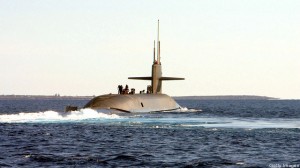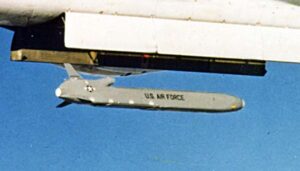LRS Bomber Shows Failings Of Obama’s Nuclear Strategy
Posted on
Lost in much of the initial coverage of the $80 billion Long Range Strike Bomber about specs and jobs is that the contract award is the latest step forward in an unnecessary and unsustainable projected spending binge to rebuild the U.S. nuclear arsenal in its current image.
According to a January 2015 Congressional Budget Office (CBO) report, the direct costs of the administration’s plans for nuclear forces will total about $350 billion between fiscal 2015 and fiscal 2024. This is just the tip of the spending iceberg, as most of these modernization programs are still in the research and development phase. Over the next 30 years, the bill could add up to $1 trillion, according to three separate independent estimates.
In addition to the Long Range Strike Bomber, the Pentagon’s plans to rebuild the “triad” of nuclear delivery systems over the next 20 years include nearly $140 billion to design and build a new fleet of ballistic missile submarines (Ohio Replacement Program), at least $62 billion on a replacement for the Minuteman III ICBM system, $20 billion to $30 billion on a new fleet of nuclear-capable Air Launched Cruise Missiles (ALCM), and additional tens of billions on improved nuclear command and control systems and refurbished nuclear warheads and their infrastructure.
Cost overruns, a far from uncommon occurrence in Pentagon and National Nuclear Security Administration (NNSA) budgeting, could well drive these projections even higher.
What is most puzzling about this all-of-the-above approach it that it would leave the United States with a larger arsenal than President Obama says is needed for U.S. security.
Though the president and his military advisers have determined that the deployed strategic nuclear arsenal can be reduced by up to one-third below the 2010 U.S.-Russia New Strategic Arms Reduction Treaty (New START) levels of 1,550 deployed strategic warheads and 700 deployed strategic delivery systems, the proposed spending is based on maintaining the New START levels in perpetuity.
Some observers argue that Russia’s increasingly reckless nuclear rhetoric and actions means the United States shouldn’t consider altering its current nuclear force posture and planning. However, both the United States and Russia maintain more nuclear weapons than they need for their security. Small numerical advantages by either side would not change the fundamental deterrence equation.
Moreover, every dollar Washington spends to maintain a bloated nuclear arsenal is a dollar that can’t be spent on military capabilities more relevant to countering Russia and assuring U.S. allies. It is not in the U.S. interest to engage in a tit for tat race with the Russians to rebuild an excessively large nuclear force.
Meanwhile, military leaders continue to warn that the United States faces a cash crunch in the near future when it comes to sustaining and modernizing nuclear forces. “[W]e do have a huge affordability problem with that basket of [nuclear weapons] systems,” said Frank Kendall, undersecretary of defense for acquisition, technology, and logistics, in April 2015. “It is starting to poke itself into the [future years defense plan] — the five-year plan now. And we’re trying to address it.”
What makes the growing cost to sustain the nuclear mission so worrisome for military planners is that costs are scheduled to peak during the 2020s and overlap with a large bow wave in projected spending on conventional weapon system modernization programs.
Though no one knows for sure what the military budget will look like after the expiration of the Budget Control Act, it seems unlikely that there will be enough money to fund all of the military’s nuclear and conventional modernization plans, especially during the decade of the 2020s when costs are expected to peak.
 Prioritizing the nuclear mission could thus do serious damage to conventional capabilities and other national security programs. For example, the Navy is fretting that without supplemental funding from outside its budget, the cost to develop and build the next generation ballistic missile submarine (ORP) fleet will crater the rest of its shipbuilding budget. Advocates of the new bomber are also worried about funding the program, and have begun to echo the Navy in calling for a special funding stream separate from the Air Force budget.
Prioritizing the nuclear mission could thus do serious damage to conventional capabilities and other national security programs. For example, the Navy is fretting that without supplemental funding from outside its budget, the cost to develop and build the next generation ballistic missile submarine (ORP) fleet will crater the rest of its shipbuilding budget. Advocates of the new bomber are also worried about funding the program, and have begun to echo the Navy in calling for a special funding stream separate from the Air Force budget.
Now is the time for the White House and Congress to chart a more realistic path for our nuclear arsenal. New START is scheduled to expire in 2021. It’s likely that Washington and Moscow will seek an arrangement to replace it. Given the need for a follow-on pact that will coincide with the projected emergence of the nuclear budget bow wave, it would be unwise to proceed full steam ahead with the current plans, which would constrain the force sizing options available to the next president.
As the Arms Control Association highlighted in our October 2014 report, “The Unaffordable Arsenal: Reducing the Costs of the Bloated U.S. Nuclear Stockpile,” there are numerous options to responsibly reshape current plans.
For example, the White House could announce it has determined that U.S. deterrence requirements do not require current plans to spend at least $62 billion to buy a new fleet of some 642 land-based ICBMs to support a deployed force of 400, and will instead base a follow-on program to support the deployment of a smaller fleet of 300 ICBMs.
In addition, as former Secretary of Defense Bill Perry has proposed, the President could halt plans for 1,000 to 1,100 new nuclear-capable Air Launched Cruise Missiles, which would cost some $20 billion to $30 billion.
The Pentagon has failed to provide compelling reasons why it needs a new penetrating bomber armed with both a nuclear gravity bomb and standoff missile in order to meet the nuclear deterrence requirements of the United States and its allies. This requirement is redundant and unnecessary.
Despite warnings from senior officials that the current modernization plans are unsustainable, the Obama administration and Congress have for the most part failed to make common-sense adjustments. They can and should trim back, and in some cases, forgo redundant and costly systems.
Kingston Reif is director for disarmament and threat reduction policy at the Arms Control Association. You can follow him on Twitter @KingstonAReif.
Subscribe to our newsletter
Promotions, new products and sales. Directly to your inbox.


